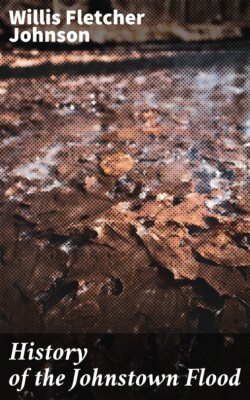Читать книгу History of the Johnstown Flood - Willis Fletcher Johnson - Страница 6
На сайте Литреса книга снята с продажи.
ОглавлениеRUINS OF JOHNSTOWN, VIEWED FROM PROSPECT HILL.
An interesting story, involving the construction and history of the Conemaugh lake dam, was related by J. B. Montgomery, who formerly lived in Western Pennsylvania, and is now well known in the West as a railroad contractor. “The dam,” said he, “was built about thirty-five years ago by the State of Pennsylvania, as a feeder for the western division of the Pennsylvania Canal. The plans and specifications for the dam were furnished by the Chief Engineer of the State. I am not sure, but it is my impression, that Colonel William Mil nor Roberts held the office at the time. Colonel Roberts was one of the most famous engineers in the country. He died several years ago in Chili. The contractors for the construction of the dam were General J. K. Moorhead and Judge H. B. Packer, of Williamsport, a brother of Governor Packer. General Moorhead had built many dams before this on the rivers of Pennsylvania, and his work was always known to be of the very best. In this case, however, all that he had to do was to build the dam according to the specifications furnished by the State. The dam was built of stone and wood throughout, and was of particularly solid construction. There is no significance in the discovery of straw and dirt among the ruins of the dam. Both are freely used when dams are being built, to stop the numerous leaks.
“The dam had three waste-gates at the bottom, so arranged that they could be raised when there was too much water in the lake, and permit the escape of the surplus. These gates were in big stone arches, through which the water passed to the canal when the lake was used as a feeder.
“In 1859 the Pennsylvania Railroad Company purchased the canal from the State, and the dam and lake went into the possession of that company. Shortly afterward the Pennsylvania Company abandoned the western division of the canal, and the dam became useless as a feeder. For twenty- five years the lake was used only as a fish-pond, and the dam and the gates were forgotten. Five years ago the lake was leased to a number of Pittsburgh men, who stocked it with bass, trout, and other game fish. I have heard it said that the waste-gates had not been opened for a great many years. If this is so, no wonder the dam broke. Naturally the fishermen did not want to open the gates after the lake was stocked, for the fish would have run out. A sluiceway should have been built on the side of the dam, so that when the water reached a certain height the surplus could escape. The dam was not built with the intention that the water should flow over the top of it under any circumstances, and if allowed to escape in that way the water was bound to undermine it in a short time. With a dam the height of this the pressure of a quantity of water great enough to overflow it must be something tremendous.
“If it is true that the waste-gates were never opened after the Pittsburgh men had leased the lake, the explanation of the bursting of the dam is to be found right there. It may be that the dam had not been looked after and strengthened of late years, and it was undoubtedly weakened in the period of twenty-five years during which the lake was not used. After the construction of the dam the lake was called the Western Reservoir. The south fork of the Conemaugh, which fed the lake, is a little stream not over ten feet wide, but even when there were no unusual storms it carried enough water to fill the lake full within a year, showing how important it was that the gates should be opened occasionally to run off the surplus.”
Mr. Montgomery was one of a party of engineers who inspected the dam when it was leased by the Pennsylvania Company, five years ago. It then needed repairs, but was in a perfectly safe condition if the water was not allowed to flow over it.
